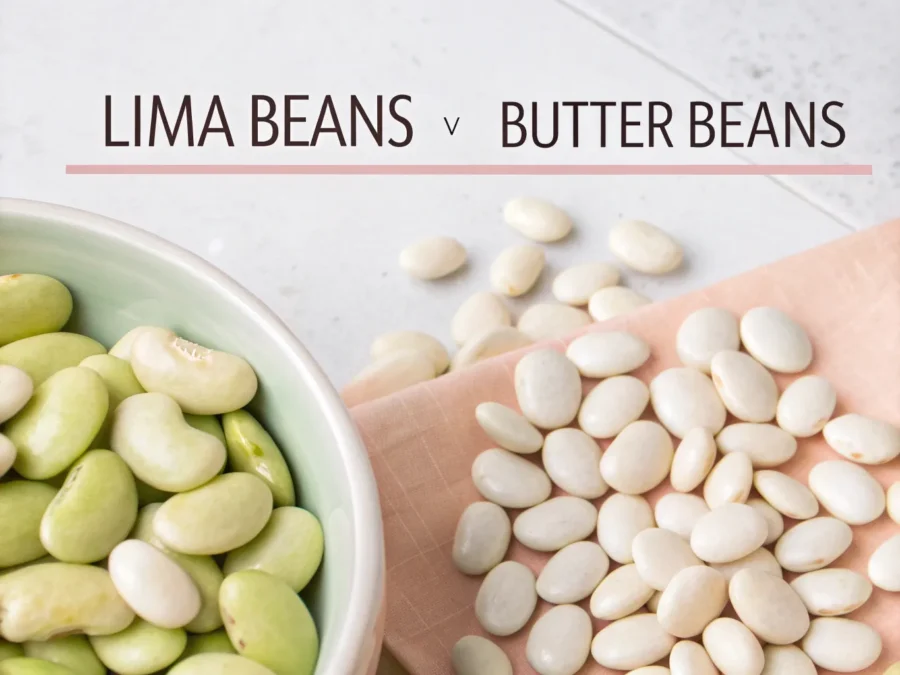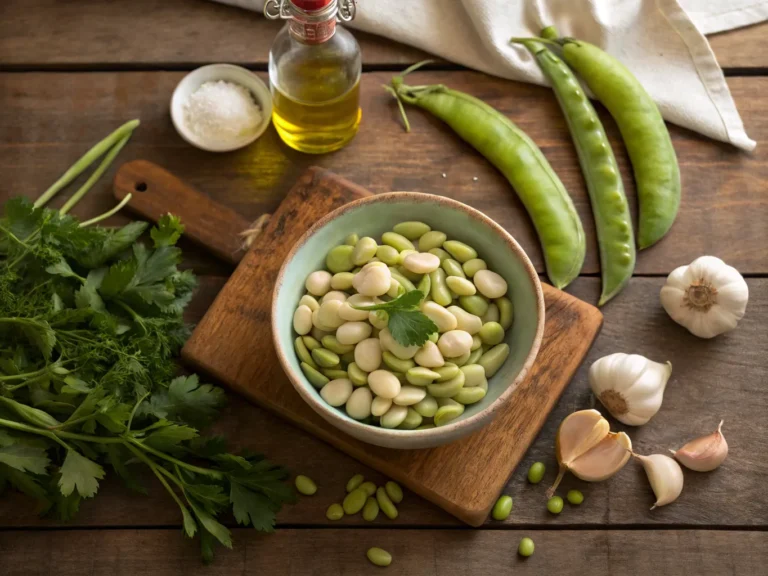Lima beans and butter beans are beloved by home cooks worldwide, yet their names often spark confusion. Are they two different types of beans or just two names for the same legume? This question has puzzled many, especially since these beans appear interchangeably in recipes.
In this article, we’ll uncover the truth behind Are lima beans and butter beans the same thing? and explore their similarities, differences, and culinary uses. By the end, you’ll know whether you can swap one for the other, how they’re perceived in different cultures, and their health benefits. Let’s dive in!
Table of Contents
Introduction to Lima Beans and Butter Beans
What Are Lima Beans?
Lima beans, scientifically known as Phaseolus lunatus, are legumes that originated in Peru, where they’ve been cultivated for over 9,000 years. Named after the Peruvian capital city, Lima, these beans come in two primary forms: baby lima beans (smaller, tender, and green) and mature lima beans (larger and cream-colored). They’re mild in flavor, slightly starchy, and pair well with many dishes.
Interestingly, lima beans have a controversial reputation. Some people adore their creamy texture and nutty undertones, while others shy away due to childhood memories of bland cafeteria meals. Regardless, they’re packed with nutritional value, including fiber, protein, and key vitamins like folate.
What Are Butter Beans?
Butter beans are simply another name for lima beans. In the United States, the term “butter beans” is more common in the South, where they’re cherished for their smooth, buttery texture when cooked. In the UK and other parts of the world, they’re widely referred to as butter beans, regardless of their stage of maturity.
Unlike baby lima beans, which are often green and fresh, butter beans are typically larger and creamier, making them perfect for hearty dishes like casseroles or stews. Their nickname likely comes from their rich, velvety texture and pale yellow hue.
The Geographic Connection Between the Two
The only true distinction between lima beans and butter beans lies in the naming conventions. While “lima beans” is the preferred term in most of the U.S., “butter beans” dominates in Southern cooking and abroad. Despite their different names, these legumes are one and the same.
So, if you’re ever wondering Are lima beans and butter beans the same thing?, the answer is yes they’re just called different names depending on where you are!
Key Similarities Between Lima Beans and Butter Beans
Lima beans and butter beans are often confused for being two separate types of legumes. However, they are simply different names for the same bean, with slight variations depending on the region and stage of maturity. Let’s explore the many similarities that connect them and answer the question, Are lima beans and butter beans the same thing?
Shared Scientific Name: Phaseolus Lunatus
One of the most important connections between lima beans and butter beans is their shared scientific name, Phaseolus lunatus. This classification confirms that they are not separate species but rather different terms for the same legume. The name “lima” comes from the capital city of Peru, where the bean was first cultivated thousands of years ago. Meanwhile, the term “butter beans” is used in Southern U.S. cooking and in countries like the UK, often referring to the mature, creamy variety.

Identical Nutritional Profiles
Another significant similarity is their nutritional content. Both lima beans and butter beans are rich in protein, fiber, and essential nutrients like iron, magnesium, and potassium. A cup of cooked beans provides:
- Protein: About 15 grams
- Fiber: 13 grams
- Folate: Essential for DNA repair and red blood cell production
These beans are a plant-based protein powerhouse, making them ideal for vegetarian and vegan diets. Whether you call them lima or butter beans, their health benefits remain identical.
Interchangeability in Recipes
Culinarily, lima beans and butter beans are completely interchangeable. Whether fresh, frozen, or dried, these beans perform similarly in dishes. For instance, in a creamy soup or hearty casserole, both varieties deliver a buttery texture and mild flavor. They can also be substituted in recipes like succotash, where their creamy consistency pairs beautifully with corn.
For more on how these beans can enhance your meals, check out Tasty Sara’s recipe for chicken and bean soup to see how beans elevate traditional dishes.
How They Are Perceived Differently
While lima beans and butter beans are fundamentally the same, cultural and regional influences shape how they are perceived and named. Understanding these differences helps clarify the nuances behind their identity.
Regional Naming Differences
The most noticeable difference lies in the name. In the United States, the term “lima beans” is more common outside of the South. However, in Southern cooking, “butter beans” reign supreme, particularly when referring to the larger, mature beans. In the UK and other countries, the term “butter beans” is used universally, regardless of the bean’s size or stage of growth.
Common Culinary Applications Around the World
Lima beans are often eaten fresh in South America, where they are harvested young and green. In contrast, butter beans are more commonly dried or canned and used in Southern U.S. dishes like creamy stews and casseroles. Around the world, these beans appear in Mediterranean recipes, Indian curries, and even West African dishes, showcasing their global appeal.
Differences in Fresh, Baby, and Mature Bean Varieties
Baby lima beans, also known as sieva beans, are tender and slightly green, offering a milder flavor and firmer texture. Mature butter beans, on the other hand, are cream-colored with a richer, buttery texture. This difference in stage impacts how they’re used in recipes:
- Baby lima beans: Ideal for salads and light sautés.
- Mature butter beans: Perfect for soups, dips, or hearty baked dishes.
So, while the terms “lima beans” and “butter beans” are used interchangeably, they often evoke different images and culinary applications depending on cultural context. Whether fresh, frozen, or dried, these beans offer endless versatility and flavor.
Nutritional and Culinary Uses
Both lima beans and butter beans are prized for their nutritional value and versatility in the kitchen. Let’s explore why they’re a staple for healthy eating and how they can elevate your meals.
Nutritional Benefits of Lima and Butter Beans
It’s no surprise that lima beans (or butter beans) are considered a nutrient-dense food. Whether you’re looking to boost your energy, improve digestion, or support your overall health, these beans deliver:
- Plant-Based Protein: A cup of cooked lima beans offers about 15 grams of protein, making them an excellent meat alternative.
- Rich in Fiber: With 13 grams of fiber per serving, they help keep your digestion smooth and your heart healthy.
- Loaded with Micronutrients: These legumes are packed with iron, magnesium, potassium, and folate, all essential for maintaining strong bones, healthy blood cells, and balanced electrolytes.
Their low glycemic index and minimal fat content make them a great option for people managing diabetes or trying to maintain a balanced diet.
Popular Dishes That Feature These Beans
The creamy texture and mild flavor of lima or butter beans make them an all-star in countless dishes. For a Southern classic, try cooking them with smoked ham hocks or bacon for a rich and savory side dish. Alternatively, Mediterranean-inspired dishes like butter bean salad with olive oil, lemon, and parsley are light and refreshing.

FAQs About Lima and Butter Beans
Many people wonder about the similarities and differences between lima beans, butter beans, and other types of legumes. Let’s clear up some common questions.
What Are Butter Beans Good For?
Butter beans are incredibly versatile! They’re great for adding protein and fiber to your meals while keeping your diet low in fat. Use them in soups, stews, salads, or even pureed into dips. Their creamy texture makes them perfect for dishes that require a velvety consistency, like casseroles or baked sides.
Are Cannellini Beans and Butter Beans the Same?
No, cannellini beans and butter beans are not the same, though they share similarities. Cannellini beans are a type of white kidney bean with a firmer texture and a more earthy flavor. They’re commonly used in Italian dishes like minestrone. Butter beans, on the other hand, are softer and have a more buttery taste, perfect for creamy dishes.
Are Butter Beans and Pinto Beans the Same?
Not at all! Pinto beans are smaller, speckled, and have a nuttier taste compared to the smooth and mild butter beans. Pintos are a staple in Mexican cuisine, while butter beans are popular in Southern and Mediterranean cooking.
Can You Use Lima Beans in Place of Butter Beans?
Yes, because lima beans and butter beans are the same thing, they can always be swapped in recipes. However, the stage of maturity matters baby lima beans have a firmer bite and a more subtle flavor, while mature butter beans are creamier and richer.
For more delicious ideas that could incorporate these beans, explore this hearty bean soup recipe. It’s a comforting dish where butter beans would shine!
Conclusion
Recap of the Main Points
So, are lima beans and butter beans the same thing? The short answer is yes! While the names might vary depending on where you are in the world, they are simply two names for the same legume: Phaseolus lunatus. The term “lima beans” is often used in the U.S., particularly for younger, greener beans, while “butter beans” is more common in the Southern U.S. and the UK, typically referring to the mature, creamy variety.
Nutritionally, lima and butter beans are a fantastic source of protein, fiber, and essential vitamins, making them a smart addition to any diet. Culturally, these beans have carved out distinct identities in different regions, with lima beans appearing fresh in lighter dishes and butter beans lending their creamy texture to hearty Southern comfort food.
Encouraging Readers to Explore Both Lima and Butter Beans
Whether you’re a fan of fresh lima beans or prefer the mature butter beans, these legumes offer endless possibilities in the kitchen. From hearty soups to light salads, there’s no shortage of delicious ways to use them. Their versatility ensures they can fit into almost any cuisine. So next time you’re cooking, don’t hesitate to experiment with lima or butter beans to create nutritious and flavorful dishes.
Final Thoughts and Inspiration
Why Lima and Butter Beans Deserve a Spot in Your Pantry
As we’ve seen, the humble lima (or butter) bean is so much more than a misunderstood legume. It’s a versatile, nutrient-packed powerhouse that can elevate almost any dish. Whether you’re using fresh baby lima beans in a salad or creamy butter beans in a casserole, these legumes deliver flavor, texture, and plenty of health benefits.
A Call to Experiment with Recipes
The next time you’re at the grocery store, pick up a bag of lima or butter beans and try them in a dish you love. Add them to your soups, pair them with rice in a Mediterranean-style bowl, or mash them for a creative dip. No matter how you use them, you’ll enjoy their creamy texture and mild, buttery flavor.

